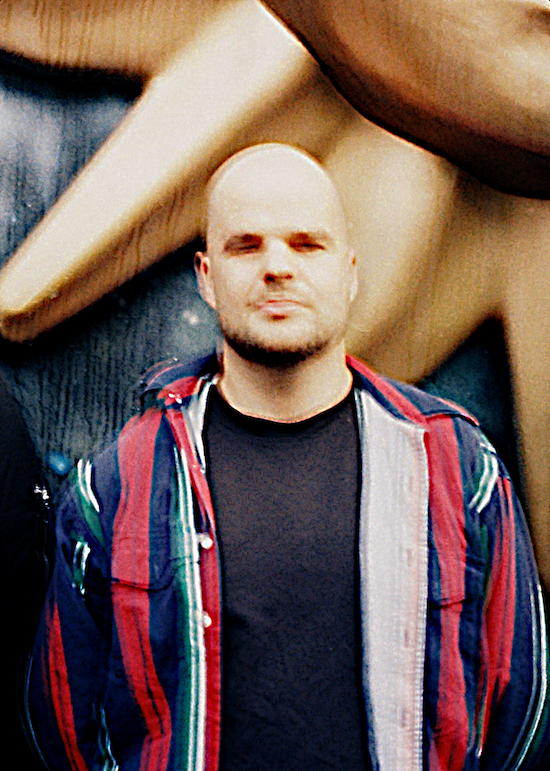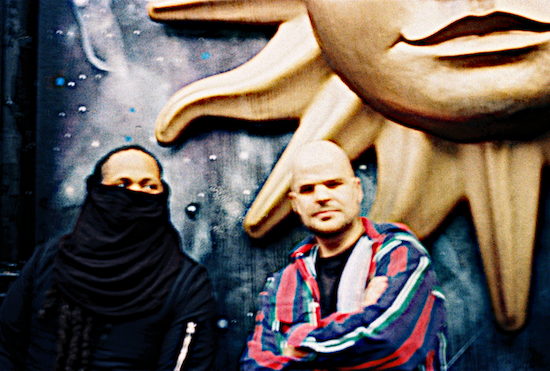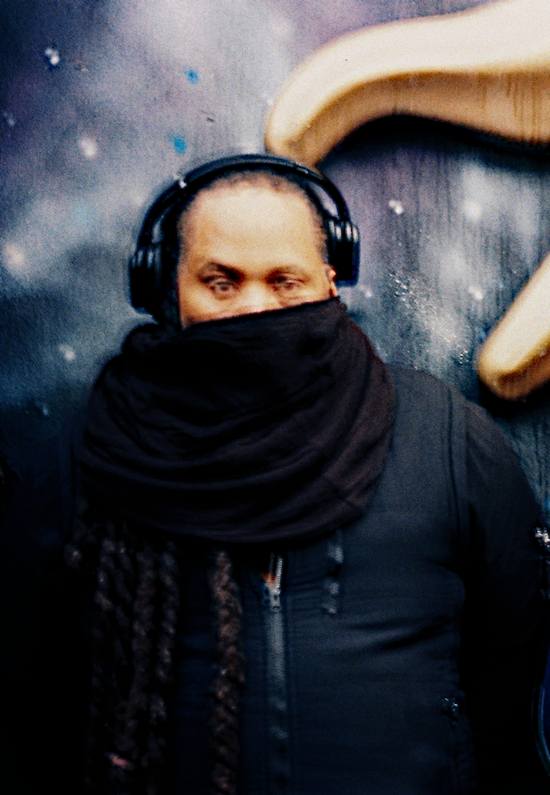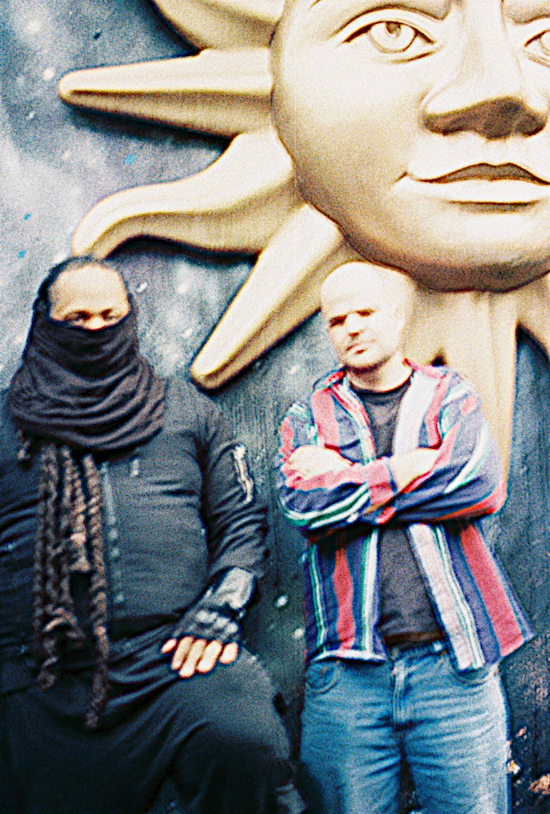Photos by Oli Warwick
The city of Amsterdam might have made a concerted effort to keep out unwanted visitors in recent times, but cosmic things still happen there, away from the stag parties and the sex tourists. Take Tune IN, a mind-altering collaborative album between Chicago electronic outlier Jamal Moss, aka Hieroglyphic Being, and rising Polish saxophone prodigy, Jerzy Mączyński.
Recorded in the space of a week in a room beneath a Dutch hotel during the summer of 2022, it captures the ad hoc rawness of two strangers jamming together, with hours of improvisational magic captured on tape, the best bits isolated, augmented and finessed. From approximately 50 hours of recorded music, the producer Rein de Sauvage Nolting pulled together 12 tracks with Mączyński putting into action what he calls his “Pelican System”. More about that shortly.
Calling themselves Universal Harmonies & Frequencies or UHF for short (a name chosen, as you might have guessed, by Moss), it’s a debut that exudes a sense of sonic simpatico, a one-off meeting of mavericks where everything fell into place under the aegis of curator Pieter Jansen from the Yeyeh label, who originally suggested the pairing. Like many of the projects Moss has been involved in, there’s a utopianism in the music and especially the titles, such as ‘Multidimensional Transformation’ and ‘Searching 4 Spirituality Without Religion’, taking inspiration from egalitarian 80s Chicago House and the enlightened proselytising of Sun Ra.
Tune IN already feels like a future classic, so savour its double-vinyl awesomeness while you can, because there’s unlikely to be another. A disagreement over artwork blew up and turned into a diplomatic incident with a passive aggressive lack of interaction after the event. Then came the much feared schism at the worst possible moment. Somewhere between UHF’s show at Bristol’s Strange Brew on 9 November and their EFG London Jazz Festival show at the Moth Club in Hackney on 13 November, Jamal Moss disappeared. He left for Berlin via Paris after playing Bristol and didn’t come back to England. Pieter Jansen tells me he “heard through his London show booker that Jamal had posted that he’d cancelled their London show.”
Jerzy Mączyński would soldier on by himself at the Moth Club, with Hieroglyphic Being’s cancellation no doubt signifying a swift end to UHF’s brief, majestic collaboration. Before the show that never was, the desired plan had been for the Quietus to meet up with Moss and Mączyński together. Moss blocked this idea, so I met up with Mączyński at his Shoreditch hotel on the day before. At that time, everything seemed to be going according to plan.
It’s a crisp, cold Sunday in east London, and Mączyński is on the steps smoking a rollup with a beanie pulled over his eyes when I arrive. We step inside for a coffee in a clean and soulless establishment. Mączyński says it reminds him of the Volkshotel Oost Amsterdam under which the sketches for Tune IN were recorded. I wonder if there were any fun extracurricular activities they got up to while recording? Maybe some cycling or an excursion to the Rijksmuseum or the Stedelijk? A lost weekend, perhaps?
Mączyński shrugs and says there wasn’t really any time for excursions. “There was stuff you could use there, like a sauna or jacuzzi, because we had cards and we could go in and out of the studio,” he remembers. “But this was the first time where I spent a full week in the studio as a musician. Normally I’m working two to three days maximum, but eight hours every day we recorded countless hours of material. Jamal’s approach was very pushy.”
He pauses for a moment to consider his wording. “I don’t know if that’s a good word – sorry for my English – but after each take he would just say ‘NEXT!’ And I was like: ‘Okay, no talking’, just ‘next’, ‘next’, ‘next’. So that produced a lot of laughs.” What was Moss like to work with? Did they build up a rapport? Was he intense? “He was…” Mączyński pauses again. “He was at that time very cool. He was very, very open, and first of all, he was on time. No delay. We spent eight hours a day just improvising in the studio. A little bit of talking – but generally about life, not about what we were doing. It was very easy. Very, very cool.”
At 28, Mączyński is almost half the age of his companion on this record, and he’s aware of certain cultural advantages he might have had over his opposite number too. “I’m coming from Poland, so first of all, my roots are different,” he says. “I’m coming from the avant-garde scene in my own country and I’m developing. I’m working for theatres as a composer right now and a little bit in the movie industry too.”
Mączyński grew up in Warsaw and won a Berkeley scholarship to study saxophone in Valencia when he was old enough to leave home. A few years ago, he moved to Berlin from Warsaw, though he spends a fair amount of time in both cities. He’s been developing the electronic side of his compositional work in order to find his own niche as a solo performer. His first solo album, 2019’s Jerry & The Pelican System, is volume 83 in an acclaimed Polish Jazz series which honours only the very best of the country’s avant-garde scene. His second album, 2021’s Sariani, was recorded during lockdown with acclaimed compatriot Wacław Zimpel, who has himself recently worked with James Holden and Shackleton. This time the artist is Jerry&ThePelicanSystem without the spaces. So what is this pelican system, exactly?

Jerzy Mączyński
“So basically, being a young avant-garde player surrounded by the mainstream, I just wanted to discover my own sound, not necessarily following the American jazz standard approach. I wanted to grab the best players from my hometown and just do my music.” On Tune IN, he took away the vast amounts of improvised collaborative material he had recorded with Moss, and with producer Rein de Sauvage Nolting, honed in on sections that could be expanded upon. ‘Fifth Science’, for instance, features a whole digital orchestra of horns and, according to Mączyński, took up to seven months to perfect. The title track, conversely, is more or less how it happened there and then in the studio, with the distorted drum machine kicking in around the six minute mark, elevating the track in the process. It’s raw, unvarnished, divine. “So, basically, it was a very pure thing, which Pieter wanted to have on the record. I wanted to produce it more and I wanted to add more colour, but the guys were saying: ‘No, no!’”
On a track like ‘Call Of The Wild’, you can probably hear the pelican system in action, if you can figure out what it is: “When you look at a pelican, you look at the size of this bird and its beak… its parts don’t necessarily look good together,” explains Mączyński, philosophically, “but on the other hand, this bird exists.” If the pelican system is the sonic equivalent of a bird that is mignon-moche, perhaps there are parallels that can be drawn with Jamal Moss’ own self-descriptive "rhythmic cubism" (Hieroglyphic Being released Synth Expressionism/Rhythmic Cubism in 2019)? Was that a factor when bridging these artists together?
“Oh, maybe?” says Mączyński. “Yeah, exactly! But actually, these kinds of questions are more for Pieter. He’s the one who put us together.” I contact Pieter and ask him whether the compatibility of rhythmic cubism and the pelican system had crossed his mind? “Obviously,” he writes back, “otherwise I wouldn’t have put so much effort, time, money and determination into making this happen. But you never know what will come out.”
In Amsterdam, Pieter Jansen is the resident programmer behind The Breakfast Club, which provides early hours beats with shakes and bio-delicacies for healthy ravers. Then there’s Yeyeh, a label with a working philosophy: “I’ve released a collaboration on Yeyeh every year,” he says. “Yeyeh is an acronym for ‘You’re Everything You’ve Ever Heard’. The label is built around the concept of actually being together in a room. A residency of some sort, I suppose,” he writes.
Mączyński says that Jansen has become a mentor figure to him, helping to steer his career and provide opportunities that he wouldn’t necessarily have thought of himself. “Haha, that sounds funny,” says Jansen. “I’ve never looked at it that way. Mączyński feels more like a friend. But yes, I do try to help him to the best of my abilities to manoeuvre his way through this industry.” That manoeuvring has worked well so far, but by bringing Moss on board, it appears they might have bitten off more than they can chew.
At the hotel, Mączyński says that he’s excited about the upcoming London show after well received gigs at the Dekmantel Festival in Amsterdam and the one in Bristol a few nights ago. His partner Katarzyna Dębska is due to fly in from Berlin to do the visuals. Just before I leave, I tell him I’ve had problems trying to nail down Moss to talk about the record, and he suggests bypassing the PR altogether and going straight to the source. “Look, I’m not his agent,” he tells me, slightly conspiratorially, “but I think it’s best if you write to him on email.” I bid him farewell, thank him for his advice, and wish him good luck with the show.
Later on, I drop Moss a line. “Greetings,” comes a swift reply. “Hope all is well with you. I’m in Berlin now. In bed. I’m under the weather trying to heal my body. I think I have Covid or RSV.” Moss gives me his WhatsApp details and then promptly disappears again for another week. I text several times, in between moments of worrying about his well being, especially when nobody appears to pick up the messages at the other end.
Then on Tuesday evening – a whole eight days after the no show at the Moth Club – I get a message: “I’m out of hospital tomorrow. Hit u up then”. I wonder if he’s still in Berlin or back in the US? “I’m in the States,” he replies. “I would never go to hospital in Europe. I’d be extra broke, it ain’t cheap”, followed by a crying emoji.
We finally get to speak the following day after he returns from hospital. The line is terrible but I decide to persist as I may not get the chance again. “How are you?” I ask. “Why were you at the hospital?”. He cuts me short. “I don’t want to put my personal medical stuff out there,” he tells me. “I just gotta be careful.”

At 50, Jamal Moss, aka Hieroglyphic Being, aka IAMTHATIAM, aka The Son God (and several other more aliases besides) has been around the block numerous times, often sleeping on people’s sofas. Born on Chicago’s South Side in 1973, these days he lives in the more upmarket West Ridge neighbourhood, which he says is mainly made up of people of Caribbean, West African and Middle Eastern heritage. Over the last decade and a half, he’s built an awesome reputation as a sonic innovator making sui generis house music, playing with artists that include Shabaka Hutchings, Hamid Drake and Angel Bat Dawid, all three of whom he mentions in our phone call. He says he makes music to “push boundaries and take things into a more enlightening, nurturing and enhancing sonic situation,” but never call him an Afrofuturist.
“Why is there an Afrofuturism but you don’t see Eurofuturism?” he asks, reasonably. “We do the same stuff that John Cage might do, or Brian Eno would do, but he’s not an Anglofuturist. I think it’s insulting. Where I come from, we already created futurist music: house, acid, techno. We don’t want to be called Afrofuturist because we created stuff on our own anyway.”
A 12-year-old Moss wandered into one of DJ Ron Hardy’s reputedly manic sets at the Music Box, a moment that makes the lineage between fledgling Chicago house and what he does now all the more tangible. “In my mind, a lot of stuff that I make does sound like the stuff that they came up with in the eighties, and the difference is, the people outside Chicago who didn’t grow up in the area I did, they really don’t have a clue. You probably got 10% on vinyl of what it sounded like in Chicago. 90% never made it to vinyl.”
He adds: “There’s tonnes of music that artists made on tapes floating around that never made it to vinyl.” Moss says he has heard mind-blowing music by legendary artists that hasn’t been released because the world doesn’t deserve it. “Those guys got disrespected, those artists got ripped off, and they were left in dire straits.”
Which artists, I wonder? “It’s up to them to tell their own stories,” he counters, “but there’s a tonne of artists in Chicago that got ripped off. That’s not a secret. We’re told there’s no money in this industry but then you read news articles about major labels turning over $4 billion profits every quarter. These investment firms or hedge funds kept buying up BMI. That’s the new crypto.”
Although Chicago – or the Chicago of the eighties – has been a major influence, Moss says his creativity is intuitive wherever he is. “I’m in places sleeping on couches making beats. I’ve lived in places with barely a bed making beats, you know? So it’s wherever I encounter in life at the time that stimulates me, either through literature, something visual, through conversation, through travels. I don’t like to use the political times, more the temperature in the room, the environment: that fuels my creativity.”
Hieroglyphic Being is never likely to be a major label artist, but he’s come a long way from hawking homemade CDRs with his Music From Mathematics imprint stamped on them. In 2015, he got to work with one of his heroes, the Arkestra’s Marshall Allen, on We Are Not The First under the name Hieroglyphic Being & J.I.T.U.Ahn-Sahm-Buhl. Other names assembled by RVNG for that showcase nu-jazz extravaganza included Shahzad Ismaily, Greg Fox and Elliott Levin. Comparisons can be drawn between that collaboration and this new one – the mingling of raw electronica and saxophone, the improvisation in a room primus inter pares – even if Mączyński is more the apprentice to Allen’s master.
“I was fortunate enough that he blessed me with the opportunity to be in the same sphere,” Moss says of Sun Ra’s nonagenarian successor. “You might think it could never happen, but it can. And I’m happy that that project broke even. They put a lot of money into it. A lot! I never thought that thing was gonna break even but it did. And it challenged me.” He’s full of praise for the way in which RVNG saw through his “vision to the best of their capabilities visually and artistically”, even though it took several years for the album to be released. All this can be interpreted as a not-so-subtle dig at his more recent employers. He continues: “I went back to the studio personally with the engineer [for We Are Not The First] and sat with them one-on-one to get the structure, which was cool because they really had me involved with the process.” Then, with a hint of bitterness in his voice, he adds: “They did not vote me out.”
As previously mentioned, the artwork seems to have been a sticking point. If Hieroglyphic Being is a gesamtkunstwerk, then compromise is not an option. “When I finally came back and I sat down with them to work out the track listing, there was a vision of how the artwork was supposed to be. But then I guess, I got outvoted. It just went somewhere different when it came to the visual perspective.”
I ask Jansen about this via email. He replies: “Throughout the whole process I made myself very clear to him that artwork, specifically, is something that will be defined by the already running art aesthetic of the label, the designer and me. After the incident, Jamal stopped communicating and didn’t want to speak about anything. I’ve tried to get in touch with him many, many times, either via messages, Instagram, WhatsApp or phone to resolve matters, to no avail.”

Jamal Moss
I wonder how Moss got on with Mączyński? Had they met before recording? “I never encountered him or the people who invited me to work on this project before. I guess they had to come up with some people that would have fit their agenda and I guess I got drawn out of a hat and they hit me up. I came in and threw whatever energy I had into the fray to hopefully see where it goes. I never heard of Jerzy before until I was introduced to him, but I’ve been introduced to a lot of foreign players.”
Moss was surprised to find they weren’t so much making up music from scratch as working on pieces Mączyński already had in his locker. “So I had to compose along to what he had, it was one of those things – we sat in with the studio engineer, and there was a videographer, which I thought was weird.” He sounds irked about that particular situation. “I don’t understand why everything had to be videotaped? Because I’m kind of weird about that. I don’t own that image anymore, and then if I die, you become a Sun Ra. You start seeing all these lost tapes and films and it’s not part of my estate because somebody else captured it.”
Moss is on a roll now. What seemed like a serendipitous arrangement soon turned into a personal nightmare for him. “I’ve had a family member die when I had to go do a concert, and I was torn between going back and offering support, and then I couldn’t because I gave my word to do certain things. I’ve been severely ill two or three times. One time I didn’t think I was gonna make it. And that’s why I feel indifferent about this project, because of all these grievances.” He says the experience challenged “my lightness and my energy and my brand”.
As we come to the conclusion of our conversation, Moss attempts to put a positive spin back on Tune IN: “Everybody go buy the music,” he implores, as if he’s talking on a live radio broadcast. “It’s out there now. I wish everybody the best, but I went through a lot of horrific stuff. These tribulations mean that in the future I have to make some different choices in life. And this cannot happen anymore. So this is my gift to the world, but this is something you have to know when you buy this music.” As Timothy Leary almost said: Turn Up. Tune IN. Drop Out.
Tune IN by Universal Harmonies & Frequencies is out now via Yeyeh


